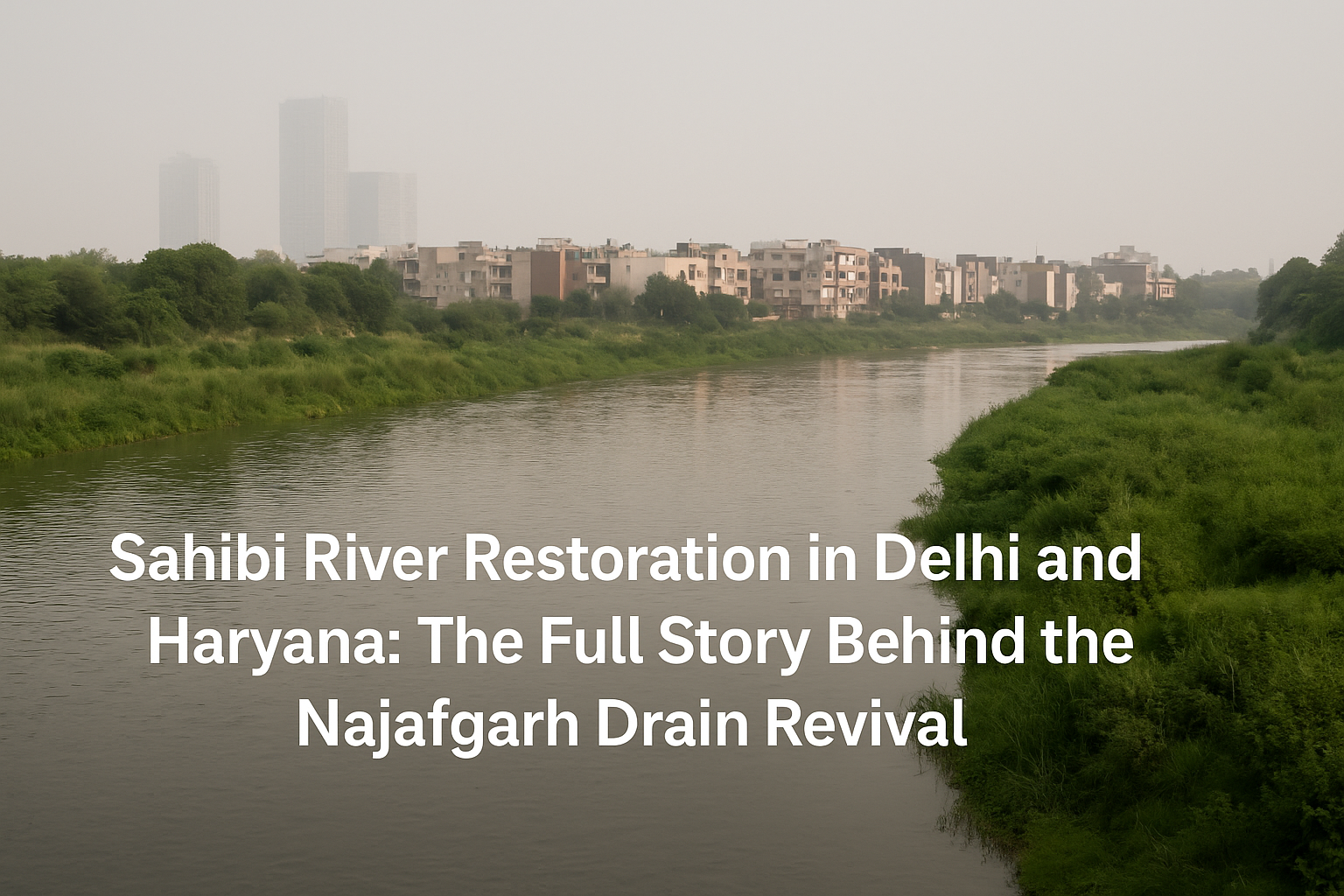Once a seasonal river flowing through Rajasthan, Haryana, and Delhi, the Sahibi River is making headlines again. Buried under decades of urban neglect and renamed the Najafgarh Drain, this forgotten waterway is finally getting a second chance.
In a coordinated effort, Delhi and Haryana have launched a joint plan to restore the Sahibi River—reclaiming lost land, reducing pollution, and reviving one of the region’s oldest natural drainage lines. This isn’t just a symbolic gesture; it’s a step toward ecological resilience, urban flood protection, and cultural memory.
Why Is the Najafgarh Drain Being Renamed the Sahibi River?
Delhi has submitted a formal proposal to rename the Najafgarh Drain as the Sahibi River. Officials argue that the term “drain” not only carries a social stigma but also affects how people, policymakers, and courts treat it.
By restoring its rightful name, authorities hope to:
- Classify the channel under river rejuvenation schemes, not just sewage lines
- Build public trust and engagement
- Unlock new legal protections and ecological restoration frameworks
“We can’t clean a river if we don’t first call it a river,” a senior official from Delhi’s Irrigation Department noted. “The name sets the narrative.”
How Haryana Is Tracing the Lost Stretch of the Sahibi River
Haryana is actively mapping an 11-kilometre stretch of the original Sahibi riverbed, now fragmented by encroachment and development. Using satellite mapping and historical surveys, the irrigation department is working to reclaim and restore this portion.
Two major outfalls—Aurangpur Link Drain and Outfall Drain No. 8—have already been reclassified as parts of the Sahibi system, providing legal clarity for future protection and cleanup.
This process also includes coordination with village authorities and private landholders—many of whom didn’t know they lived on top of a buried river.
What Historical Maps Reveal About the Sahibi River’s Origin
Archival records from 1807 and 1885 refer to the waterway as Sabee Nullah or the Najafgarh Canal, indicating its earlier status as a monsoon-fed river flowing into the Yamuna. These maps are now part of Delhi’s case before the National Green Tribunal (NGT), serving as historical proof that the channel is a natural watercourse, not just a manmade drain.
This historical validation strengthens the case for:
- Wetland protection status
- Inclusion in city master plans
- Reclassification under urban river frameworks
Why Reviving the Sahibi River Could Help Delhi’s Environmen
The Sahibi may no longer be a perennial river, but its revival has far-reaching benefits for urban ecology, resilience, and health. Here’s how:
- Flood mitigation: A natural riverbed can absorb stormwater surges, especially in flood-prone parts of West Delhi and Gurugram.
- Groundwater recharge: Reconnected floodplains allow seasonal water to seep back into depleted aquifers.
- Urban cooling: Vegetated river corridors reduce surrounding temperatures and trap air pollutants.
- Biodiversity corridor: The Sahibi supports seasonal wetlands like Najafgarh Jheel, home to migratory birds such as flamingos and cranes.
- Public health and recreation: A restored river with clean walkways offers physical, emotional, and environmental wellness to urban populations.
“It’s not about turning it into a tourist spot. It’s about giving the river—and the people—a second chance,” said a Delhi-based urban planner.
Delhi’s Plan to Restore the Najafgarh Drain as the Sahibi River
Delhi’s strategy is both symbolic and infrastructural. The city plans to:
- Develop a 60-km green corridor along the river’s edge for walking, cycling, and public access
- Construct 11 decentralized sewage treatment plants (STPs) to intercept waste from West Delhi colonies
- Re-landscape the embankments with native vegetation and wetland buffers
- Improve access roads, signage, and safety measures along the river stretch
By repositioning the Najafgarh Drain as a river corridor, Delhi hopes to create a space that’s functional, ecological, and civic.
Legal and Institutional Backing for the Sahibi Revival
Delhi’s proposal to rename the drain is currently with the State Names Authority. Simultaneously, the city has submitted a broader plan to the National Green Tribunal (NGT), backed by engineering studies, pollution audits, and historical documentation.
In Haryana, the revival plan is led by the State Irrigation and Water Resources Department, with GIS mapping and contour-level checks underway.
Central coordination is also being sought to:
- Link the project with Yamuna Action Plan extensions
- Seek Ministry of Environment support for wetland rejuvenation
- Secure funding through the AMRUT or Namami Gange programs
Challenges in Reviving the Sahibi River
Despite momentum, several barriers remain:
- Encroachments and illegal land use along the river’s original route
- High sewage discharge into the drain, including industrial effluents
- Inter-agency friction between DDA, DJB, MCD, and Haryana urban authorities
- The seasonal nature of flow, which makes long-term rehydration difficult without upstream water management
Still, the alignment between Delhi and Haryana gives the plan more credibility than past proposals.
Why the Sahibi River Revival Matters for Delhi NCR
This effort is about more than one water body. It’s about how a city views its natural systems. In Delhi, most waterways are either dead or dismissed. Reviving the Sahibi shows what’s possible when historical insight, legal clarity, and ecological planning come together.
The restoration won’t be fast. It may not be complete. But even a partial revival could reshape how Delhi treats its other neglected rivers and drains—and inspire similar transformations across India.
FAQs
What is the Sahibi River and where does it flow?
The Sahibi River is a seasonal river that originates in Rajasthan and flows through Haryana before entering Delhi, where it merges into the Yamuna River. It is currently known in Delhi as the Najafgarh Drain.
Why is the Najafgarh Drain being renamed as the Sahibi River?
Delhi officials are renaming the Najafgarh Drain to restore the river’s historical and ecological identity. The term “drain” is seen as stigmatizing, whereas calling it a river helps reposition it for legal protection, ecological restoration, and public awareness.
What steps are Delhi and Haryana taking to revive the Sahibi River?
Delhi is planning to develop a 60-kilometre riverfront corridor, build decentralized sewage treatment plants, and landscape the embankments. Haryana is tracing and reclaiming 11 kilometres of the river’s original path that has been encroached or lost.
Is the Sahibi River restoration a legally supported project?
Yes, the restoration efforts have been submitted to the State Names Authority and the National Green Tribunal. Historical maps and legal documentation are being used to support the river’s official recognition and revival.
How will the Sahibi River revival help Delhi’s environment?
A restored Sahibi River can reduce urban flooding, recharge groundwater, cool surrounding areas, and support wetland biodiversity, especially around the Najafgarh Jheel. It also offers potential for public recreation and urban greenery.
What challenges could affect the Sahibi River revival?
Major challenges include illegal encroachments, sewage discharge, lack of consistent water flow, and the need for inter-agency coordination between Delhi and Haryana.

